N,N-Dimethyl-anthranilic Acid from Calvatia nipponica Mushroom Fruiting Bodies Induces Apoptotic Effects on MDA-MB-231 Human Breast Cancer Cells
Abstract
1. Introduction
2. Materials and Methods
2.1. General Experimental Procedures
2.2. Fungus Material
2.3. Extraction and Separation of the Compounds
2.4. Cell Culture
2.5. Cell Viability Assay
2.6. Annexin V Staining
2.7. Western Blotting Analysis
2.8. Statistical Analysis
3. Results
3.1. Bioactivity-Guided Fractionation
3.2. Isolation and Structural Elucidation of Compounds 1–14
3.3. Effects of Isolated Compounds s 1–14 on Viability of MDA-MB-231 Cells
3.4. Image-Based Cytometric Analysis of N,N-Dimethyl-Anthranilic Acid (1)
3.5. Effects of N,N-Dimethyl-Anthranilic Acid (1) on Apoptosis Signaling Pathways in MDA-MB-231 Cells
4. Discussion
5. Conclusions
Supplementary Materials
Author Contributions
Funding
Data Availability Statement
Conflicts of Interest
References
- Curado, M.P. Breast cancer in the world: Incidence and mortality. Salud Pública México 2011, 53, 372–384. [Google Scholar]
- Odle, T.G. Adverse effects of breast cancer treatment. Radiol. Technol. 2014, 85, 297M–319M. [Google Scholar] [PubMed]
- Townsend, D.M.; Tew, K.D.; He, L.; King, J.B.; Hanigan, M.H. Role of glutathione S-transferase Pi in cisplatin-induced nephrotoxicity. Biomed. Pharmacother. 2009, 63, 79–85. [Google Scholar] [CrossRef] [PubMed]
- Shrivastava, A.; Kuzontkoski, P.M.; Groopman, J.E.; Prasad, A. Cannabidiol Induces Programmed Cell Death in Breast Cancer Cells by Coordinating the Cross-talk between Apoptosis and AutophagyCBD Induces Programmed Cell Death in Breast Cancer Cells. Mol. Cancer Ther. 2011, 10, 1161–1172. [Google Scholar] [CrossRef] [PubMed]
- Fulda, S. Modulation of apoptosis by natural products for cancer therapy. Planta Med. 2010, 76, 1075–1079. [Google Scholar] [CrossRef]
- Gordaliza, M. Natural products as leads to anticancer drugs. Clin. Translational Oncol. 2007, 9, 767–776. [Google Scholar] [CrossRef]
- De Silva, D.D.; Rapior, S.; Fons, F.; Bahkali, A.H.; Hyde, K.D. Medicinal mushrooms in supportive cancer therapies: An approach to anti-cancer effects and putative mechanisms of action. Fungal Divers. 2012, 55, 1–35. [Google Scholar] [CrossRef]
- Lam, Y.; Ng, T.; Wang, H. Antiproliferative and antimitogenic activities in a peptide from puffball mushroom Calvatia caelata. Biochem. Biophys. Res. Commun. 2001, 289, 744–749. [Google Scholar] [CrossRef]
- Ng, T.B.; Lam, Y.W.; Wang, H. Calcaelin, a new protein with translation-inhibiting, antiproliferative and antimitogenic activities from the mosaic puffball mushroom Calvatia caelata. Planta Med. 2003, 69, 212–217. [Google Scholar] [CrossRef]
- Roland, J.; Chmielewicz, Z.; Weiner, B.; Gross, A.; Boening, O.; Luck, J.; Bardos, T.; Reilly, H.C.; Sugiura, K.; Stock, C.C. Calvacin: A new antitumor agent. Science 1960, 132, 1897. [Google Scholar] [CrossRef]
- Lee, S.; Park, J.Y.; Lee, D.; Seok, S.; Kwon, Y.J.; Jang, T.S.; Kang, K.S.; Kim, K.H. Chemical constituents from the rare mushroom Calvatia nipponica inhibit the promotion of angiogenesis in HUVECs. Bioorg. Med. Chem. Lett. 2017, 27, 4122–4127. [Google Scholar] [CrossRef]
- Lee, S.; Lee, D.; Lee, J.C.; Kang, K.S.; Ryoo, R.; Park, H.J.; Kim, K.H. Bioactivity-guided isolation of anti-inflammatory constituents of the rare mushroom Calvatia nipponica in LPS-stimulated RAW 264.7 macrophages. Chem. Biodivers. 2018, 15, e1800203. [Google Scholar] [CrossRef]
- Lee, S.; Lee, D.; Ryoo, R.; Kim, J.-C.; Park, H.B.; Kang, K.S.; Kim, K.H. Calvatianone, a sterol possessing a 6/5/6/5-fused ring system with a contracted tetrahydrofuran B-ring, from the fruiting bodies of Calvatia nipponica. J. Natural Prod. 2020, 83, 2737–2742. [Google Scholar] [CrossRef]
- Lee, B.S.; So, H.M.; Kim, S.; Kim, J.K.; Kim, J.; Kang, D.; Ahn, M.; Ko, Y.; Kim, K.H. Comparative evaluation of bioactive phytochemicals in Spinacia oleracea cultivated under greenhouse and open field conditions. Arch. Pharm. Res. 2022, 45, 795–805. [Google Scholar] [CrossRef]
- Cho, H.; Kim, K.H.; Han, S.H.; Kim, H.; Cho, I.; Lee, S. Structure determination of heishuixiecaoline A from Valeriana fauriei and its content from different cultivated regions by HPLC/PDA Analysis. Nat. Prod. Sci. 2022, 28, 181–186. [Google Scholar] [CrossRef]
- Yu, J.S.; Jeong, S.Y.; Li, C.; Oh, T.; Kwon, M.; Ahn, J.S.; Ko, S.; Ko, Y.; Cao, S.; Kim, K.H. New phenalenone derivatives from the Hawaiian volcanic soil-associated fungus Penicillium herquei FT729 and their inhibitory effects on indoleamine 2,3-dioxygenase 1 (IDO1). Arch. Pharm. Res. 2022, 45, 105–113. [Google Scholar] [CrossRef] [PubMed]
- Lee, S.R.; Lee, B.S.; Yu, J.S.; Kang, H.; Yoo, M.J.; Yi, S.A.; Han, J.; Kim, S.; Kim, J.K.; Kim, J.; et al. Identification of anti-adipogenic withanolides from the roots of Indian ginseng (Withania somnifera). J. Ginseng. Res. 2022, 46, 357–366. [Google Scholar] [CrossRef]
- Lee, K.H.; Kim, J.K.; Yu, J.S.; Jeong, S.Y.; Choi, J.H.; Kim, J.; Ko, Y.; Kim, S.; Kim, K.H. Ginkwanghols A and B, osteogenic coumaric acid-aliphatic alcohol hybrids from the leaves of Ginkgo biloba. Arch. Pharm. Res. 2021, 44, 514–524. [Google Scholar] [CrossRef]
- Lewis, E.A.; Adamek, T.L.; Vining, L.C.; White, R.L. Metabolites of a blocked chloramphenicol producer. J. Natural Prod. 2003, 66, 62–66. [Google Scholar] [CrossRef]
- De Luca, L.; Giacomelli, G.; Porcheddu, A. Beckmann rearrangement of oximes under very mild conditions. J. Org. Chem. 2002, 67, 6272–6274. [Google Scholar] [CrossRef]
- Siddegowda, M.S.; Yathirajan, H.S.; Ramakrishna, R.A. A ligand-free and base-free copper catalyzed reaction: Arylation of ammonia and primary amines as their acetate salts. Tetrahedron Lett. 2012, 53, 5219–5222. [Google Scholar] [CrossRef]
- Zhou, Y.; Gao, G.; Li, H.; Qu, J. A convenient method to reduce hydroxyl-substituted aromatic carboxylic acid with NaBH4/Me2SO4/B (OMe) 3. Tetrahedron Lett. 2008, 49, 3260–3263. [Google Scholar] [CrossRef]
- Bolyog-Nagy, E.; Udvardy, A.; Joó, F.; Kathó, Á. Efficient and selective hydration of nitriles to amides in aqueous systems with Ru (II)-phosphaurotropine catalysts. Tetrahedron Lett. 2014, 55, 3615–3617. [Google Scholar] [CrossRef]
- Lü, W.W.; Gao, Y.J.; Su, M.Z.; Luo, Z.; Zhang, W.; Shi, G.B.; Zhao, Q.C. Isoindolones from Lasiosphaera fenzlii Reich. and their bioactivities. Helvetica Chim. Acta 2013, 96, 109–113. [Google Scholar] [CrossRef]
- Zhang, D.; Liang, C.; Xiulan, X.; Bo, L. Study on chemical components of blackberry seed oil and its antioxidant activity. Zhongguo Liangyou Xuebao 2011, 26, 55–58. [Google Scholar]
- Chen, Y.-K.; Kuo, Y.-H.; Chiang, B.-H.; Lo, J.-M.; Sheen, L.-Y. Cytotoxic activities of 9, 11-dehydroergosterol peroxide and ergosterol peroxide from the fermentation mycelia of Ganoderma lucidum cultivated in the medium containing leguminous plants on Hep 3B cells. J. Agric. Food chem. 2009, 57, 5713–5719. [Google Scholar] [CrossRef]
- Kawahara, N.; Sekita, S.; Satake, M. Steroids from Calvatia cyathiformis. Phytochemistry 1994, 37, 213–215. [Google Scholar] [CrossRef]
- Amagata, T.; Tanaka, M.; Yamada, T.; Doi, M.; Minoura, K.; Ohishi, H.; Yamori, T.; Numata, A. Variation in cytostatic constituents of a sponge-derived Gymnascella dankaliensis by manipulating the carbon source. J. Natural Prod. 2007, 70, 1731–1740. [Google Scholar] [CrossRef]
- Xu, X.; Lai, Y.; Hua, Z.-C. Apoptosis and apoptotic body: Disease message and therapeutic target potentials. Biosc. Rep. 2019, 39, BSR20180992. [Google Scholar] [CrossRef]
- Kasibhatla, S.; Tseng, B. Why target apoptosis in cancer treatment? Mol. Cancer Ther. 2003, 2, 573–580. [Google Scholar]
- Kantari, C.; Walczak, H. Caspase-8 and bid: Caught in the act between death receptors and mitochondria. Biochim. Biophysica Acta BBA Mol. Cell Res. 2011, 1813, 558–563. [Google Scholar] [CrossRef]
- Kang, M.H.; Reynolds, C.P. Bcl-2 inhibitors: Targeting mitochondrial apoptotic pathways in cancer therapy. Clin. Cancer Res. 2009, 15, 1126–1132. [Google Scholar] [CrossRef]
- Gupta, S.; Kass, G.E.; Szegezdi, E.; Joseph, B. The mitochondrial death pathway: A promising therapeutic target in diseases. J. Cell. Mol. Med. 2009, 13, 1004–1033. [Google Scholar] [CrossRef]
- Wang, Y.; Luo, W.; Wang, Y. PARP-1 and its associated nucleases in DNA damage response. DNA Repair 2019, 81, 102651. [Google Scholar] [CrossRef]
- Zheng, X.P.; Cui, Q.F.; Zhao, J.F.; Yang, L.J.; Zhang, H.B.; Yang, X.D.; Li, L. Three new phthalides from Gnaphalium adnatum. Helvetica Chim. Acta 2014, 97, 1638–1643. [Google Scholar] [CrossRef]
- Choudhary, A.; Kumar, R.; Srivastava, R.B.; Surapaneni, S.K.; Tikoo, K.; Singh, I.P. Isolation and characterization of phenolic compounds from Rhodiola imbricata, a Trans-Himalayan food crop having antioxidant and anticancer potential. J. Funct. Foods 2015, 16, 183–193. [Google Scholar] [CrossRef]
- Chen, S.; Yong, T.; Xiao, C.; Su, J.; Zhang, Y.; Jiao, C.; Xie, Y. Pyrrole alkaloids and ergosterols from Grifola frondosa exert anti-α-glucosidase and anti-proliferative activities. J. Funct. Foods 2018, 43, 196–205. [Google Scholar] [CrossRef]
- Xiao, L.-G.; Zhang, Y.; Zhang, H.-L.; Li, D.; Gu, Q.; Tang, G.-H.; Yu, Q.; An, L.-K. Spiroconyone A, a new phytosterol with a spiro [5, 6] ring system from Conyza japonica. Org. Biomol. Chem. 2020, 18, 5130–5136. [Google Scholar] [CrossRef]
- Zhao, F.; Xia, G.; Chen, L.; Zhao, J.; Xie, Z.; Qiu, F.; Han, G. Chemical constituents from Inonotus obliquus and their antitumor activities. J. Natural Med. 2016, 70, 721–730. [Google Scholar] [CrossRef] [PubMed]
- Wu, H.-Y.; Yang, F.-L.; Li, L.-H.; Rao, Y.K.; Ju, T.-C.; Wong, W.-T.; Hsieh, C.-Y.; Pivkin, M.V.; Hua, K.-F.; Wu, S.-H. Ergosterol peroxide from marine fungus Phoma sp. induces ROS-dependent apoptosis and autophagy in human lung adenocarcinoma cells. Sci. Rep. 2018, 8, 17956. [Google Scholar] [CrossRef] [PubMed]
- Gao, J.; Wang, L.-W.; Zheng, H.-C.; Damirin, A.; Ma, C.-M. Cytotoxic constituents of Lasiosphaera fenzlii on different cell lines and the synergistic effects with paclitaxel. Natural Prod. Res. 2016, 30, 1862–1865. [Google Scholar] [CrossRef]
- Lee, S.; Lee, S.; Roh, H.-S.; Song, S.-S.; Ryoo, R.; Pang, C.; Baek, K.-H.; Kim, K.H. Cytotoxic constituents from the sclerotia of Poria cocos against human lung adenocarcinoma cells by inducing mitochondrial apoptosis. Cells 2018, 7, 116. [Google Scholar] [CrossRef] [PubMed]

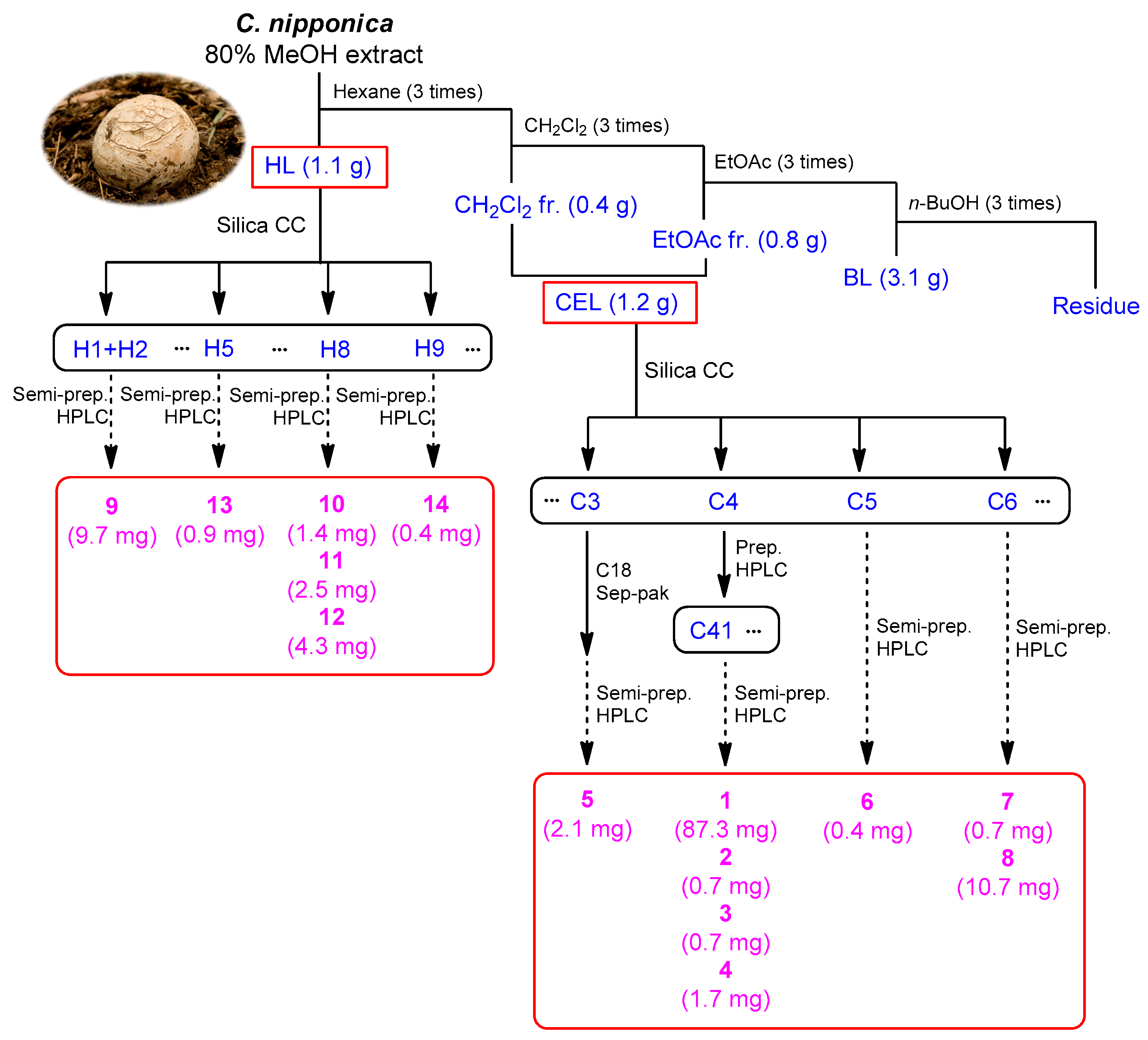

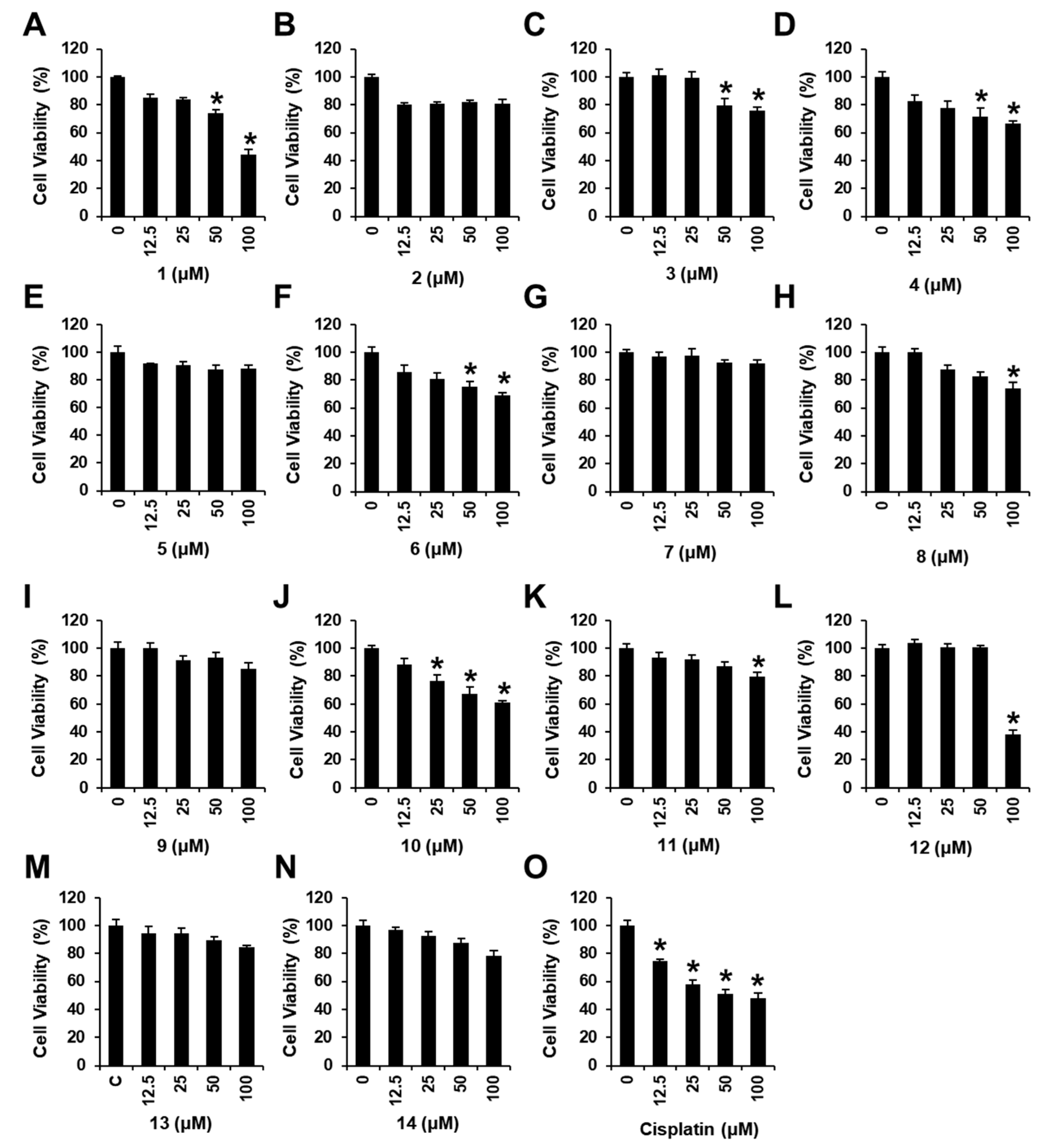
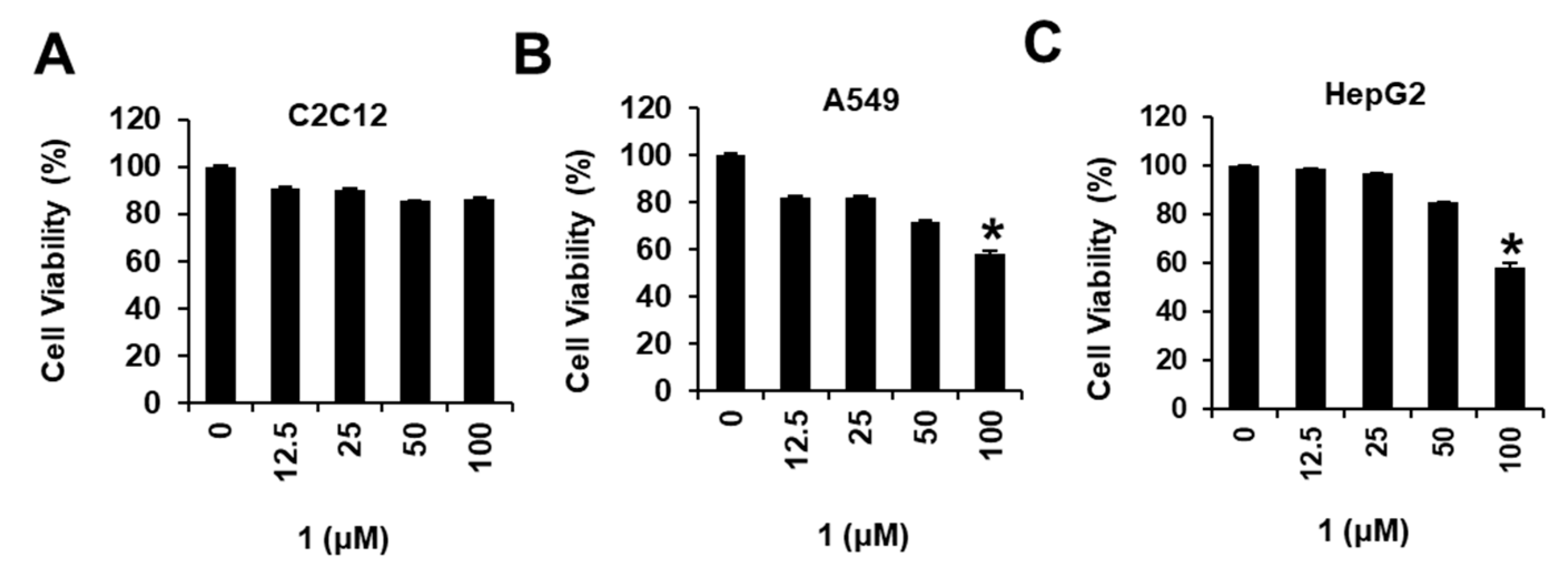
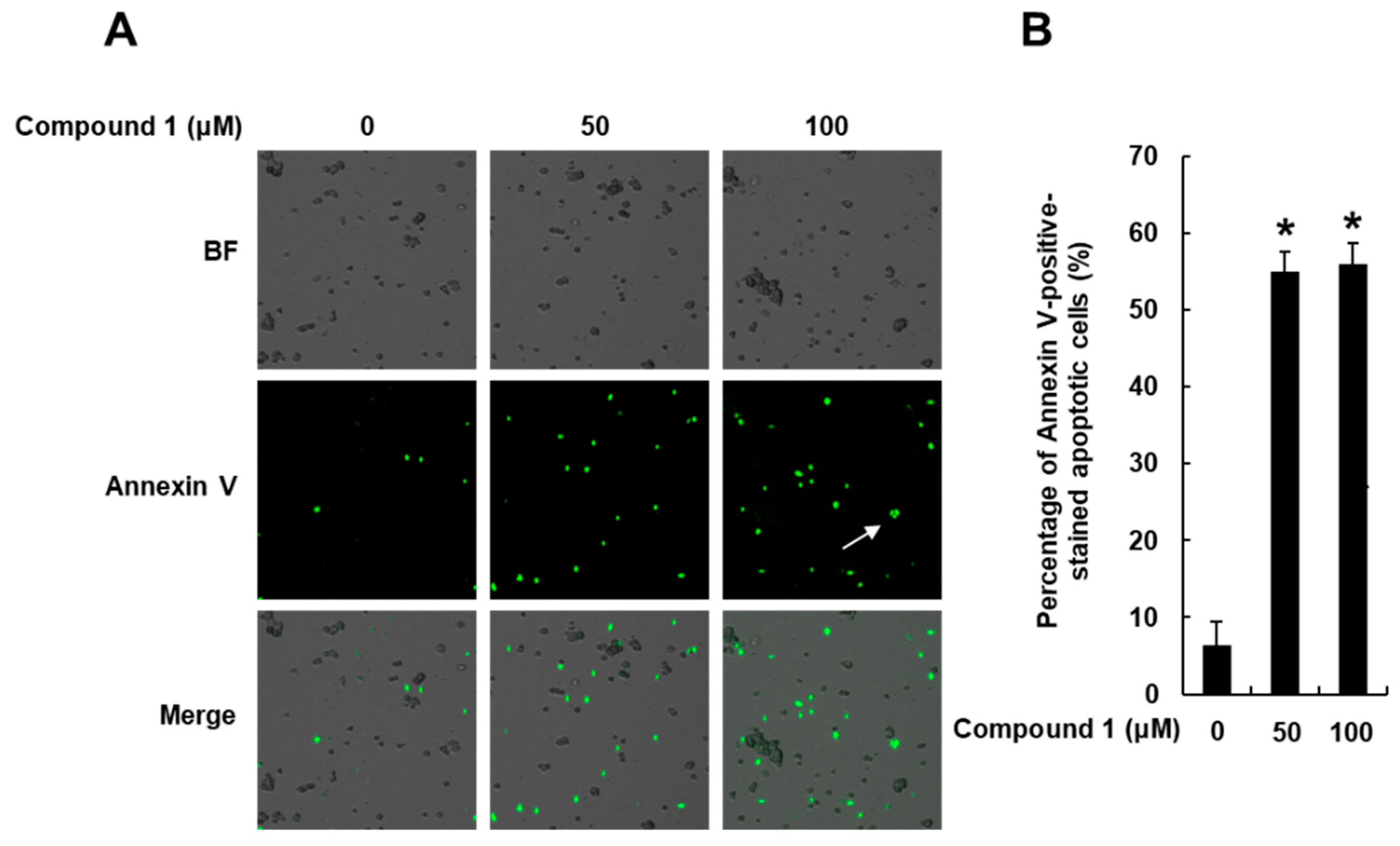
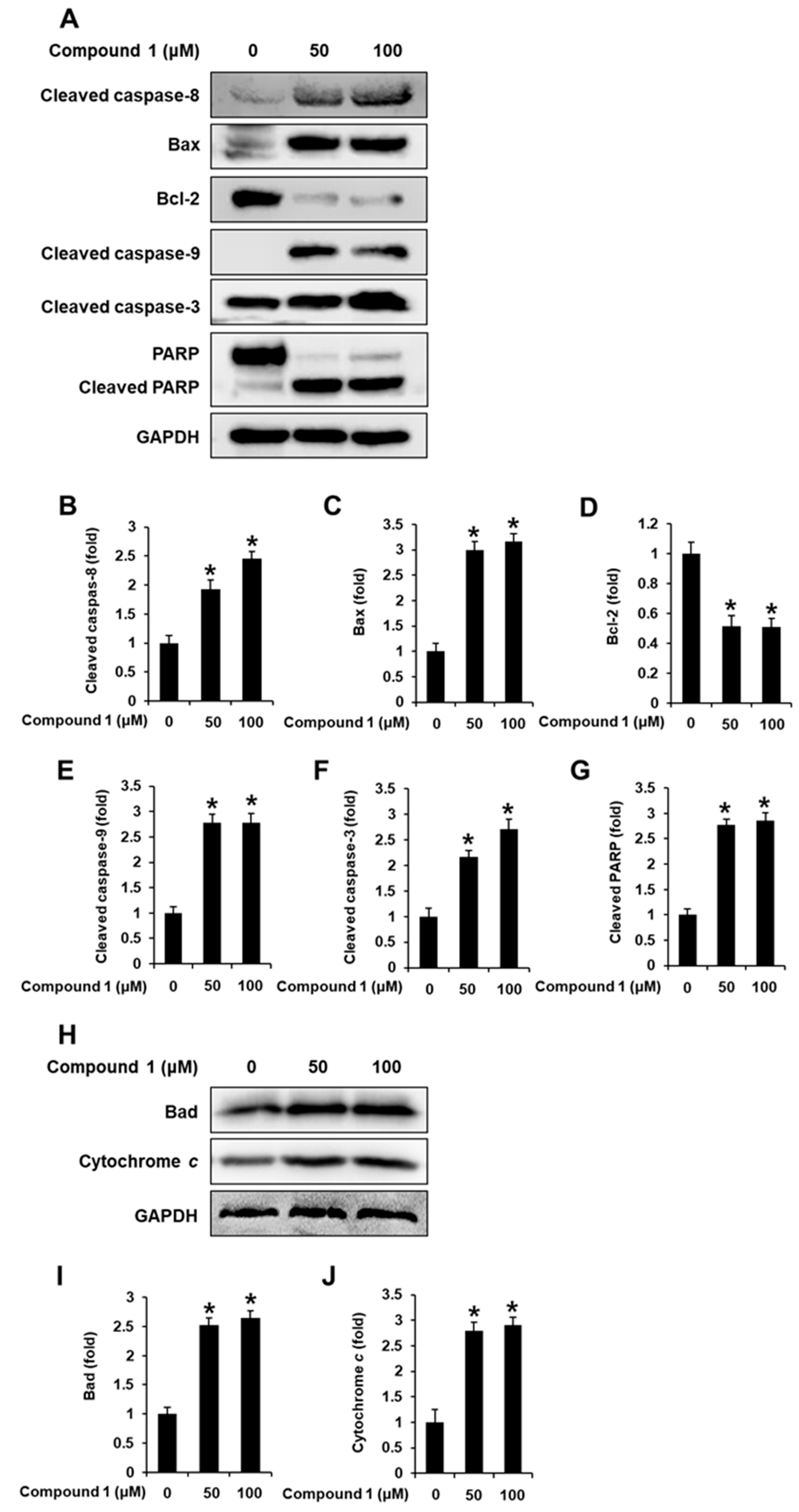
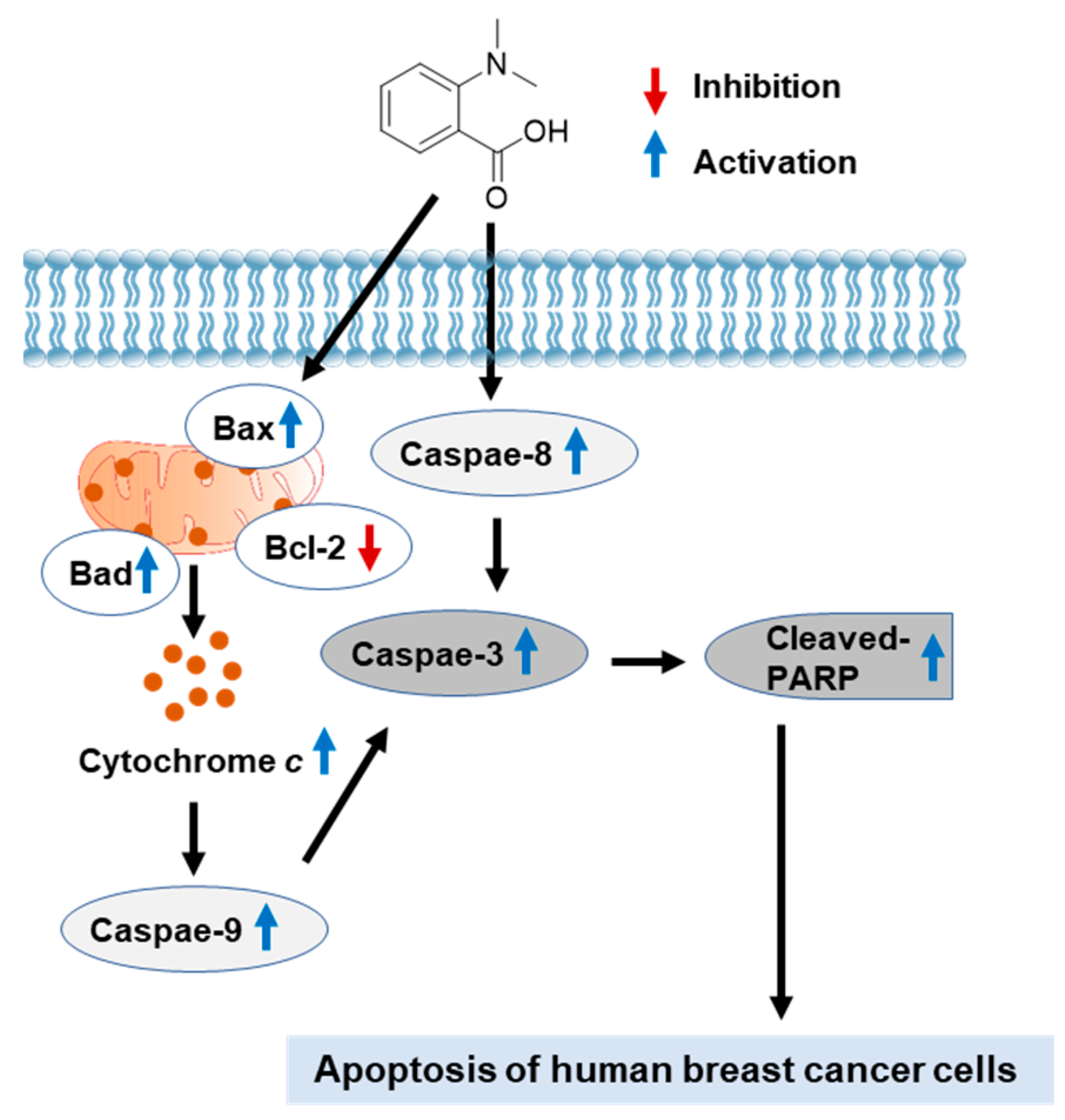
Disclaimer/Publisher’s Note: The statements, opinions and data contained in all publications are solely those of the individual author(s) and contributor(s) and not of MDPI and/or the editor(s). MDPI and/or the editor(s) disclaim responsibility for any injury to people or property resulting from any ideas, methods, instructions or products referred to in the content. |
© 2023 by the authors. Licensee MDPI, Basel, Switzerland. This article is an open access article distributed under the terms and conditions of the Creative Commons Attribution (CC BY) license (https://creativecommons.org/licenses/by/4.0/).
Share and Cite
Lee, D.; Lee, S.; Jang, Y.S.; Ryoo, R.; Kim, J.K.; Kang, K.S.; Kim, K.H. N,N-Dimethyl-anthranilic Acid from Calvatia nipponica Mushroom Fruiting Bodies Induces Apoptotic Effects on MDA-MB-231 Human Breast Cancer Cells. Nutrients 2023, 15, 3091. https://doi.org/10.3390/nu15143091
Lee D, Lee S, Jang YS, Ryoo R, Kim JK, Kang KS, Kim KH. N,N-Dimethyl-anthranilic Acid from Calvatia nipponica Mushroom Fruiting Bodies Induces Apoptotic Effects on MDA-MB-231 Human Breast Cancer Cells. Nutrients. 2023; 15(14):3091. https://doi.org/10.3390/nu15143091
Chicago/Turabian StyleLee, Dahae, Seulah Lee, Yoon Seo Jang, Rhim Ryoo, Jung Kyu Kim, Ki Sung Kang, and Ki Hyun Kim. 2023. "N,N-Dimethyl-anthranilic Acid from Calvatia nipponica Mushroom Fruiting Bodies Induces Apoptotic Effects on MDA-MB-231 Human Breast Cancer Cells" Nutrients 15, no. 14: 3091. https://doi.org/10.3390/nu15143091
APA StyleLee, D., Lee, S., Jang, Y. S., Ryoo, R., Kim, J. K., Kang, K. S., & Kim, K. H. (2023). N,N-Dimethyl-anthranilic Acid from Calvatia nipponica Mushroom Fruiting Bodies Induces Apoptotic Effects on MDA-MB-231 Human Breast Cancer Cells. Nutrients, 15(14), 3091. https://doi.org/10.3390/nu15143091







